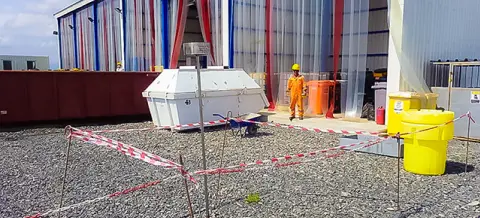Safe Workplace
Workplace Attestation
Azecolab offers comprehensive workplace attestation to ensure compliance with health and safety regulations. Our services include evaluating potential hazards, reviewing safety protocols, and providing actionable recommendations to enhance workplace safety.
We cater to various industries, ensuring that your organization maintains a safe and compliant environment for all employees.
"*" indicates required fields
What is industrial hygiene?
According to https://www.osha.gov industrial hygiene has been defined as “that science and art devoted to the anticipation, recognition, evaluation, and control of those environmental factors or stresses arising in or from the workplace, which may cause sickness, impaired health and well-being, or significant discomfort among workers or among the citizens of the community.” Detailed information is available in the OHSA guidance for industrial hygiene.


What is workplace attestation?
Workplace attestation is the procedure required according to the legislation of the Republic of Azerbaijan. The methodology and the map of the procedure is documented in the normative act. Azecolab industrial hygiene tests include all the parameters listed in this act. According to Azerbaijan legislation workplace attestation shall be performed at least once in 5 years.
Azecolab Industrial Hygiene Tests
Azecolab’s qualified specialists provide:
On-site measurements for noise, radiation, vibration, illumination, and other physical hazards.
Laboratory testing for volatile organic compounds (VOCs), dust, and chemical contaminants.
Hazard and risk assessment services, ensuring comprehensive workplace safety evaluations.
All our equipment holds NIST, UKAS, or TURKAK traceable calibration certificates, ensuring the highest quality and accuracy in performed on-site measurements. Our service scope includes both individual laboratory testing and full hazard identification and risk assessment services. The provided test reports can help businesses achieve OHSAS 18001 certification while meeting Azerbaijan’s legal requirements.
Potential Hazards Assessed by Azecolab
We assess a range of workplace hazards, including:

Physical Hazards
Excessive levels of ionizing and non-ionizing radiation, noise, vibration, illumination, and extreme temperatures.
Chemical Hazards
Harmful chemical compounds in solids, liquids, gases, mists, dusts, fumes, and vapors. Exposure through inhalation, skin absorption, or ingestion.
Biological Hazards
Bacteria, viruses, fungi, and other living organisms that cause acute and chronic infections.

Ergonomic Hazards
Issues such as eye strain, repetitive motion injuries, and heavy lifting problems.

Air contaminants
Dusts, fumes, fibers,
gases, aerosols
Our Workplace Assessment Process
01
Preparation and Planning
- Conducting an inventory of all workstations.
- Establishing an attestation commission within the enterprise.
- Defining the methodology and schedule for assessments.
02
Evaluation of Workplace Conditions
Azecolab, as an accredited laboratory, conducts independent workplace assessments based on strict regulatory standards. Our role is to provide precise measurements and analyses rather than an all-inclusive service. The evaluation covers:
Read More
Read More
- Measuring and analyzing physical, chemical, biological, and ergonomic hazards using validated methodologies and accredited laboratory techniques.
- Ensuring compliance with sanitary and hygiene norms through accurate, standardized assessments.
- Assessing psychosocial risks and workload intensities based on established benchmarks.
- Verifying the effectiveness of personal protective equipment (PPE) in alignment with industry best practices.
Read Less..
03
Workplace Hazard Assessment
- Instrumental measurements of environmental factors such as noise, vibration, radiation, and air quality.
- Identification of harmful production factors that require control measures.
- Verification of safety compliance for machinery, tools, and work processes.
04
Risk Mitigation and Recommendations
- Identifying necessary improvements and corrective measures.
- Developing an action plan to eliminate or reduce workplace hazards.
- Recommending best practices to enhance occupational health and safety.
05
Documentation and Compliance Reporting
- Preparing a comprehensive attestation report, including workplace classification by safety level.
- Submitting attestation results to the State Labor Inspectorate Service within 10 working days.
- Maintaining attestation records for a minimum of 45 years, as required by law.
Key Benefits of Our Workplace Assessment Services

Compliance with Azerbaijani labor laws and safety regulations

Reduction in workplace injuries and occupational diseases

Improved employee well-being and productivity

Avoidance of legal penalties and sanctions

Access to expert recommendations for improving working conditions
Why Choose Azecolab?
Azecolab is an ISO 17025 accredited laboratory, ensuring that workplace assessments are conducted with the highest level of accuracy, reliability, and compliance. Our evaluations follow strict protocols, and we deliver objective, independent results that help businesses maintain workplace safety in accordance with regulatory standards.
Ensure the safety and well-being of your workforce with Azecolab’s Workplace Assessment Services. Contact us today to schedule your workplace attestation and stay compliant with Azerbaijani labor laws!
Download Our ISO/IEC 17025 Accreditation Scope
Accredited for Excellence in Testing & Calibration
Our laboratory is ISO/IEC 17025 accredited for both Testing and Calibration, ensuring the highest level of quality, reliability, and compliance in our services.

Testing Laboratory Accreditation – Verified for precision in environmental, chemical, and microbiological testing.

Calibration Laboratory Accreditation – Accredited for highly accurate instrument calibration and metrological traceability.
For any inquiries or custom testing/calibration needs:
Frequently Asked Questions
What types of testing does Azecolab provide?
Azecolab offers a wide range of testing services, including water, air, and soil analysis, oil and fuel testing, food and beverage testing, microbiology, chemical analysis, and calibration services.
How can I submit a sample for testing?
You can submit your samples by visiting our laboratory, scheduling a pickup service, or mailing your samples following our sample collection guidelines. Please contact us for specific instructions based on the type of test required.
How long does it take to receive test results?
Turnaround times depend on the type of analysis being conducted. Standard tests typically take 5–7 business days, while more complex tests may require additional time. Expedited services are available upon request.
Are Azecolab’s tests accredited and compliant with regulations?
Yes, Azecolab adheres to international quality standards and is accredited under recognized bodies to ensure accuracy and reliability. We comply with ISO, EPA, ASTM, and other industry regulations.
Why Choose Us?
Certified & Experienced Experts
Fast & Accurate Testing
Compliance with Regulatory Standards
Customer-Centric Service
Request a Consultation
Your Safety, Our Priority – Fill out the form below, and our experts will get back to you as soon as possible to assist with your inquiry.
"*" indicates required fields